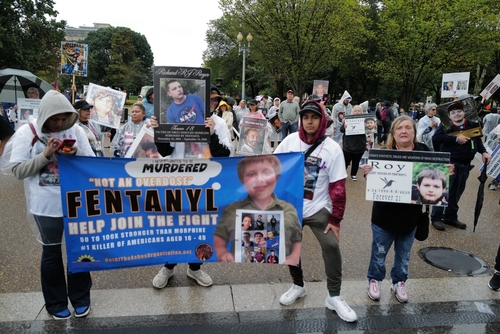Two dozen people drop to the pavement in Baltimore from a mass drug overdose, while politicians and bureaucrats in City Hall keep spinning the same old lines—and taxpayers are left wondering how many more crises it takes before anyone in power actually does something that works.
Two Dozen Hospitalized: Baltimore’s Latest Mass Overdose Shows Systemic Failure
On the morning of July 10th, at the infamous intersection of Pennsylvania and North Avenue, Baltimore’s opioid nightmare reared its head again. At least 25 people collapsed from overdoses in broad daylight, five of them now fighting for their lives in critical care. Emergency responders declared a “level one mass casualty event,” a phrase that’s becoming all too common in a city that’s spent years chasing its own tail on drug policy. While officials scrambled to triage and transport the victims, residents of Penn–North—already weary from years of violence, poverty, and failed promises—watched as their neighborhood became the backdrop for another headline-grabbing disaster.
Within hours, politicians and bureaucrats had their statements ready. Baltimore Fire Chief James Wallace summarized the chaos, while State’s Attorney Ivan Bates reminded everyone that the opioid crisis is still raging—because apparently, we all needed the reminder. The city’s health department rushed to point out that they’d coordinated overdose reversal efforts, and the mayor’s office issued its routine press release. The police, meanwhile, launched an investigation into the source of the drugs, the results of which history suggests will be buried in committee meetings and news cycles long before anyone is held accountable.
Public Resources Stretched, Residents Frustrated, and Political Leaders in the Hot Seat
The immediate fallout from the mass overdose was predictable: hospitals flooded with critical patients, first responders stretched to their limits, and the city’s emergency services put on high alert for the next wave. The trauma rippled through the community, where residents already living under the shadow of addiction and instability found themselves at the epicenter of a public health crisis that never seems to end. As ambulances lined the block and news crews swarmed the scene, the city’s leaders faced a familiar chorus of outrage and demands for accountability. But if history is any guide, the response will be more of the same—task forces, press conferences, and roundtable discussions that never quite translate into safer streets or fewer body bags.
UPDATE on mass overdose incident in Penn-North, #Baltimore yesterday
• 27 people hospitalized; 7 in critical condition; 15 stable
**No fatalities reported
• Substance still being tested; drug not yet disclosed
• Police seeking info on the source; call 1-866-LOCKUP @wmar2news pic.twitter.com/LqnfuHiuKN— Mallory Sofastaii (@mal_sofastaii) July 11, 2025
While city officials talk about “root causes” and “systemic solutions,” taxpayers are left footing the bill for emergency interventions that treat the symptoms, not the disease. Harm reduction programs and overdose prevention have become the city’s go-to answers, but the effectiveness of these strategies is undermined by persistent lawlessness, an overwhelmed justice system, and a lack of political will to confront the criminal networks fueling the crisis. Meanwhile, the Penn–North neighborhood—already battered by economic decline and public neglect—now faces even greater stigma and scrutiny, while the broader Baltimore community wonders just how many more mass overdoses it will take before anything changes.
Expert Opinions Highlight a Broken System and Call for Real Accountability
Public health experts are quick to point out that mass overdoses like this one are usually the result of contaminated or hyper-potent fentanyl batches. Their solution? Expand access to naloxone, drug checking, and community outreach. That’s all well and good, but without a serious crackdown on the criminal suppliers and a political class willing to get tough on crime and drugs, these events will only become more frequent. Academic commentators, meanwhile, drone on about poverty, housing, and healthcare access—as if the average taxpayer hasn’t heard it all before—while law enforcement insists that supply chain disruption and criminal prosecution are the only paths to real change.
BREAKING
: (BALTIMORE ,MD) Baltimore police are now at the corner of West North Avenue and Pennsylvania Avenue in West Baltimore after about 15 people overdosed. Five were quickly taken to the hospital, but one died. Tests are happening on site for others. The mobile command… pic.twitter.com/TgLOg6tHhE
— Officer Lew (@officer_Lew) July 10, 2025
In the aftermath, city officials talk a big game about transparency and coordination. The mayor’s office, health department, and emergency services all pat themselves on the back for their “swift response.” State’s Attorney Ivan Bates says this is a “stark reminder” of the ongoing opioid crisis. But for families in Baltimore, for taxpayers across America, and for anyone who still believes that law, order, and common sense should prevail, the real reminder is this: when policy fails and accountability is just another buzzword, it’s the innocent who pay the price—again and again.
Sources:
Click this link for the original source of this article.
Author: Editorial Team
This content is courtesy of, and owned and copyrighted by, https://ourpatriot.com and its author. This content is made available by use of the public RSS feed offered by the host site and is used for educational purposes only. If you are the author or represent the host site and would like this content removed now and in the future, please contact USSANews.com using the email address in the Contact page found in the website menu.








